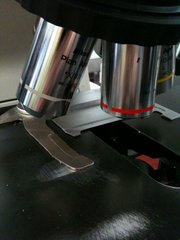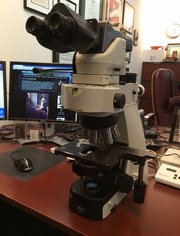What is Dermatopathology?
Dermatopathology (dermato = skin; pathology = a study of disease): the medical discipline whose practitioners study and make judgments about the diseases of the skin by means of evaluating through a microscope the histopathological structure of lesions in cutaneous biopsies and excisions. The discipline also includes studying skin diseases by means of histochemistry, immunohistochemistry, electron microscopy, and molecular biological techniques when necessary. Those who practice dermatopathology usually have an MD or DO medical degree but may also have other credentials.
Dermatopathology Standards
. . . it must be remembered that a technical standard can never be substituted for one's judgment of the facts, i.e., a diagnostic standard. The diagnostic standard requires that the information from each case be integrated fully and the clinical context be considered carefully prior to drawing any conclusions. The diagnostic standard is the ultimate purpose of any technical standard, and dermatopathologists must not allow themselves to use the latter as a justification for abdicating their responsibilities as interpreters of and decision makers about complex medical information.
Whither Dermatopathology?
What is a diagnosis? The term means literally to "know across." The Oxford English Dictionary defines it as the "determination of the nature of a diseased condition; identification of disease by careful investigation of its symptoms and history; also the opinion (formally stated) resulting from such investigation." In the modern era of medicine, the "tried and true" approach to understanding a disease consists of observation, comparison, more observation, more comparison, review of previously gathered data, review of literature, acquisition of additional data, re-review, and, at some point, integration of all the data into a cohesive whole.
Dysplastic Nevus? -- There is no such nevus.
No one knows the mechanism(s) by which a melanocyte within control skin or within a melanocytic nevus becomes the nidus of a melanoma. This is why the designations ‘‘precursor’’ and (even worse) ‘‘premalignant melanocytic dysplasia’’ are so problematic. By the time one recognizes a given lesion for what he thinks it is, its nature is already determined and, in most instances, diagnosable. . . .

Types of melanoma?
. . . the problem with the diagnosis of melanoma is the
diagnosis of melanoma. Melanomas have different patterns, often in the same
lesion; the diagnosis and margin definition often are difficult to establish
regardless of pattern in a given tumor; and the prognosis for a given patient is
not understood simply by applying a ‘‘type’’ with a Breslow measurement, a Clark
level, and commenting on the presence of ulceration -- and it never will. Why
is this? It is because each melanoma plays out in its own way if given enough
time, given any particular patient’s immune status and context
clinicopathologically.
Mark A. Hurt, MD
Excerpted from: Types of
melanoma?
J Am Acad Dermatol 2008; 58:1059-1060
Diagnosis
Melanocytic Nevus vs Melanoma
A "Right" to Health Care?
If your diagnosis is at stake, then your life is at stake as well as the lives of every individual you love. If you care about your diagnosis, then don’t allow the Rights of Man to be infringed further without a fight.
If you wish to live as a human being, then help return the practice of medicine to the private practice of medicine.
Mark A. Hurt, MD
Excerpted from: Selfishness at the Microscope: Your Diagnosis or Your Life.
A speech delivered at: Redeeming Reform: What Health Care Reform Could Be and Ought to Be. A Briefing at the National Press Club, Washington, D.C., May 10, 2010. Sponsored by Americans for Free Choice in Medicine.



